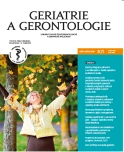Virtual reality as a way of keeping seniors activ in retirement homes.
Authors:
Mgr. Věra Suchomelová; Th. D. D; Mgr. Karolína Diallo; Ph. D. D
Authors‘ workplace:
Teologická fakulta Jihočeské univerzity, České Budějovice
Published in:
Geriatrie a Gerontologie 2019, 8, č. 3: 115-118
Category:
Original Article
Overview
In this paper we have outlined the development of a set of virtual experiences as a tool for keeping active the residents in senior home facilities. Unlike other technologies, virtual reality (VR) can provide the user with an almost perfect feeling of physical being in an imaginary world or a place representing reality and the user can actively influence the storyline. A quantitative survey among managers of senior facilities and the residents showed that both groups of respondents are interested in this new way of keeping seniors active. As for the content of the virtual reality experience, both groups strongly preferred a forest environment and an environment associated with travel. In addition, a survey among residents showed a strong need to be a part of the community. To some extent, this need may be met by a suitable virtual environment scenario, but even more so by the chance to share virtual experiences with others. Keeping seniors active in virtual reality should support social interaction in the senior’s real world and correspond to the framework of activities in the facility.
Keywords:
activation – elderly – virtual reality – virtual environment – immersivity – interactivity – emotions – needs
Sources
1. Corno G, Bouchard S & Forget H. Usability Assessment of the Virtual Multitasking Test (V-MT) for Elderly People. Annual Review of Cybertherapy and Telemedicine 2014; 199 : 168–172.
2. García-Betances R, Jiménez-Mixco V, Arredondo M, Cabrera-Umpiérrez M. Using Virtual Reality for Cognitive Training of the Elderly. American Journal of Alzheimer‘s Disease and Other Dementias 2014; 30 (1): 49-54.
3. Mirelman A, Rochester L, Maidan I, et al. Addition of a non–immersive virtual reality component to treadmill training to reduce fall risk in older adults (V–TIME): A randomised controlled trial. Lancet 2016; 388 : 1170 – 1182.
4. Li A, Montaño Z, Chen VJ, Gold JI. Virtual reality and pain management: current trends and future directions. Pain Management 2011; 1(2): 147–157.
5. Chirico A, Ferrise F, Gaggioli A. Designing Awe in Virtual Reality: An Experimental Study. Frontiers in Psychology 2018; 22 (8): 1–14.
6 Lin Ch, Lee Ch, Lally D, Coughlin JF. Impact of Virtual Reality (VR) Experience on Older Adults‘ Well-Being. Massachusetts Institute of Technology Integrate 2018.
7. Waterworth J, Riva G. Feeling Present in the Physical World and in Computer-Mediated Environments. Basingstoke: Palgrave Macmillan 2014.
8. Erichsen NB, Büssing A. Spiritual needs of elderly living in residential/nursing homes. Evidence-based Complementary and Alternative Medicine 2013, article No. 913247.
Labels
Geriatrics General practitioner for adults Orthopaedic prostheticsArticle was published in
Geriatrics and Gerontology

2019 Issue 3
- Memantine Eases Daily Life for Patients and Caregivers
- Hope Awakens with Early Diagnosis of Parkinson's Disease Based on Skin Odor
- Metamizole vs. Tramadol in Postoperative Analgesia
- Memantine in Dementia Therapy – Current Findings and Possible Future Applications
Most read in this issue
- Selected tools for evaluation of geriatric fragility
- Virtual reality as a way of keeping seniors activ in retirement homes.
- Geriatric scales and rehabilitation after proximal femur fractures.
- Influence of reminiscence therapy on health condition and quality of life of seniors in long-term hospital care - preliminary results
